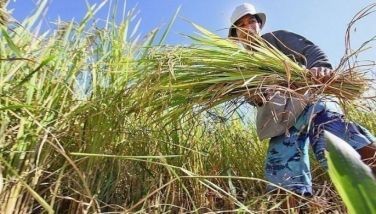The future is green Quezon province eyed as Phl herbal capital
MANILA, Philippines – In July 2014, Typhoon Glenda hit the country causing billions of pesos in damages. The Quezon province suffered the biggest blow with some P2 billion worth of agricultural crops and facilities destroyed.
But every cloud, as the saying goes, has a silver lining.
The Quezon provincial government soon launched a rehabilitation caravan to to help survivors by distributing relief packs to thousands of families in badly devastated areas.
During this campaign, the Office of the Provincial Agriculturist (OPA) introduced its herbal program as a possible livelihood alternative to residents.
Many local government officials responded positively to the concept, having been oriented on the increasing global demand for medicinal plants as an alternative way to health and wellness.
Herbal farming sounded like an economically viable proposition. Based on a study published in the World Journal of Pharmaceutical Research in 2015, the global market for herbal medicines currently stands at over $60 billion annually. The sale of herbal medicines is expected to get higher at an average annual growth rate of 6.4 percent.
The global market for all herbal supplements and remedies could reach US$115 billion by 2020, with Europe and the Asia-Pacific as the largest and the fastest-growing markets.. In another article published in the International Journal of Academic Research in Accounting, Finance and Management Sciences in 2013, the herbal industry is expected to grow to $5 trillion by 2050.
Herbal medicines have been widely used in the Philippines long before modern Western medications were introduced. In many rural areas in the Philippines in the past and up until now, the albularyo is a prominent and sought-after person for his ability to cure common diseases.
There is an astounding variety of medicinal plants in the Philippines. Health advocacy group Alay Kapwa Kilusang Pangkalusugan (AKAP) has been able to list 1,297 plants in the Philippines that are known to have folk medicinal uses.
There are reportedly 9,000 different plant species, 60 percent of which are believed to be endemic to the Philippines. So far, fewer than 500 of those species have been identified to have medicinal uses.
In 1992, then Health Secretary Juan Flavier parlayed his decades of experience as a barrio doctor into championing the use of herbal drugs.
During his term as Health Secretary, the DOH endorsed 10 Philippine plants clinically tested to have medicinal value. He also co-authored the Traditional and Alternative Medicine Act that gave legal recognition to natural healing side by side with pharmaceutical drugs. It was signed into law (RA 8423) by then President Fidel Ramos in 1997.
The law also created the Philippine Institute of Traditional and Alternative Health Care, a state-owned corporation supervised by the DOH designed to promote scientific research on medicinal herbs and plants.
Given the increasing awareness of the health benefits of herbal medicines and the growing demand for plant-based products globally, the Herbal Program envisioned by the provincial government of Quezon, was immediately set to motion.
In 2014, Quezon Gov. David Suarez issued an EO that created the QHIP committee composed of different government agencies, academic institutions and representatives from the private sector.
The QHIP committee drafted the Herbal Industry Development Program, which focuses on five major areas: research and development, enhancement of herbal production, information and education, promotion and marketing, and agro-enterprise development.
Before the year was over, the provincial government led by Gov. Suarez conducted its first-ever Quezon Herbal Conference with the theme, “The Prospects of Herbal Plants in Quezon Province” in Tayabas City. The conference brought together municipal mayors, municipal agriculturists, municipal health officers, department heads of the provincial government of Quezon, non-government organizations, academic institutions and herbal health advocates.
Participants were briefed on the significance of the Traditional and Alternative Medicine Act, the herbal plants found in Quezon province, the global market positioning of the Philippines, processing and manufacturing herbal plants as medicines, and business opportunities in essential oils, among others.
The provincial government identified co-operators (individuals, groups, cooperatives) to participate in the production and processing of selected medicinal plants that have huge market demand. Six towns were initially chosen as pilot areas for the program and were given planting materials.
Various forms of assistance were provided to the chosen co-operators, including needs assessment, training in production and product development, provision of equipment and tools, and financial management.
On May 26, 2015, Gov. Suarez led the signing of a memorandum of agreement between Quezon, the local government of Atimonan, and Department of Environment and Natural Resources Region IV-A for the beautification of the Quezon Protected Landscape (formerly Quezon National Park) and developing it as another tourist destination in the province.
It also marked the groundbreaking ceremony for the Quezon Protected Landscape (QPL) Herbal Pavilion along the iconic zigzag road known as Bitukang Manok in Atimonan.
Along with recreational facilities for visitors, the QPL Herbal Pavilion will have a display center for products made by different organizations, cooperatives and individuals involved in the Herbal Program. It will be a sanctuary for different types of medicinal plants and other species endemic to Quezon province, making it an ideal destination for those who want to enjoy nature and feel its healing power.
Gov. Suarez is unequivocal about his vision when he said “I want Quezon province to be the center of herbal medicine in our country, where all kinds of herbal plants and requirements can be acquired.”
He also sees this initiative as a way of promoting environmental protection and rehabilitation by providing alternative jobs for those who still resort to cutting trees and slash-and-burn activities in the area.
With the targeted opening of the QPL Herbal Pavilion this year, Quezon province is well on its way to becoming the “Herbal Capital of the Philippines.”
- Latest

























